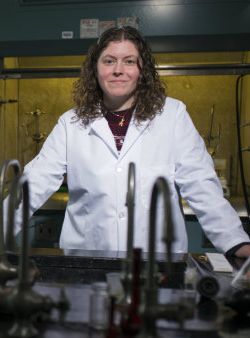The structure of cross-linked polymeric gels is very similar to soft tissue―which is one reason that understanding this material is so critical, according to Kelly Schultz, assistant professor of chemical and biomolecular engineering.
Schultz was part of a special session of the American Institute of Chemical Engineers (AIChE) Annual Meeting in Pittsburgh last month, where she was invited to present her lab’s work determining how increasing the concentrations of polymers in solution changes the structure of cross-linked gels. The title of the session was “AIChE Journal Futures: New Directions in Chemical Engineering Research.”
Schultz’s talk was based on a paper she contributed by invitation to AIChE’s inaugural “Futures" issue designed to highlight the work of early career researchers. The paper, co-authored by her former Ph.D. student, Matthew Wehrman, and four Lehigh undergraduates, is called "Rheological properties and structure of step‐ and chain‐growth gels concentrated above the overlap concentration.”
“Increasing the concentration of polymers enables them to interact,” says Schultz. “These interactions can change the structure of the material and even potentially weaken it.”
Through experiments, she and her team discovered that the structure of cross-linked polymeric gels is independent of concentration, until a limit is reached—called the overlap concentration—which is when the polymers begin to interact. After this limit, the structure is again independent of concentration.
The group’s central discovery is that more polymers does not necessarily mean the gel will be more elastic or stiffer.
“This was unexpected,” says Schultz. “We thought that there would be a gradual change in the scaffold structure but instead there is a step change when these interactions become high enough.”
Identifying this characteristic could be of particular importance for industrial applications as the team’s work shows that these cross-linked polymeric gel structures can be achieved with a smaller amount of polymer.
“In other words,” says Schultz, “you can get the result you want with the least amount of material.”
Schultz’s work on this is novel because of how her team looked at scaffolds at high polymer concentrations—or with polymeric interactions. Most studies, she says, stay under the overlap concentration so that polymer interactions do not complicate gelation.
“With this work, chemical engineers may begin to understand how polymeric interactions change gel structure and how these structures can be accessed at relatively low polymer concentrations,” says Schultz.
Last year, Schultz, who is also affiliated with Lehigh's Institute for Functional Materials & Devices (I-FMD), received a National Science Foundation (NSF) CAREER Award. The grant will support exploration of a promising area of biomaterials and cell biology that uses human mesenchymal stem cell (hMSC) encapsulated in hydrogels to enhance cell motility and, in turn, cell delivery if the scaffold is implanted into a wound. Schultz’s work in this area was recently featured on the cover of Rheology Bulletin (Volume 87 Number 2, July 2018), published semi-annually by the Society of Rheology (SOR).
Read the full article in the Lehigh University News Center.
-Lori Friedman is a Director of Media Relations with Lehigh University's Office of Communications and Public Affairs.

